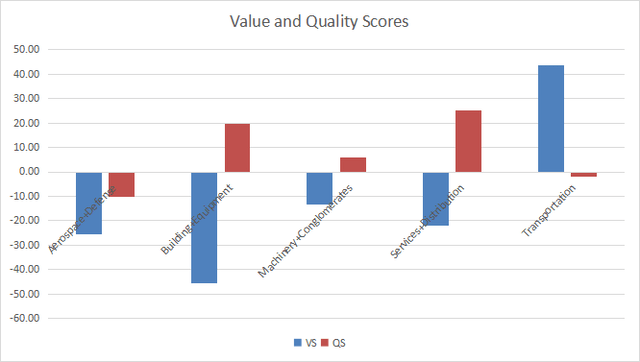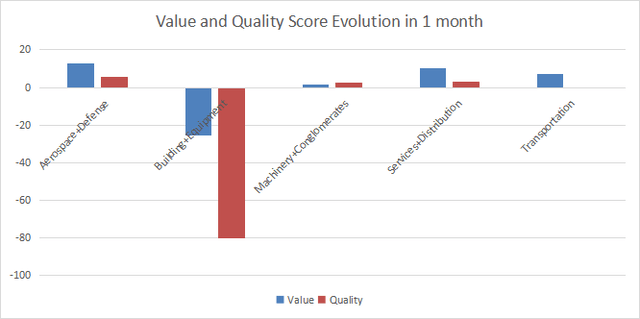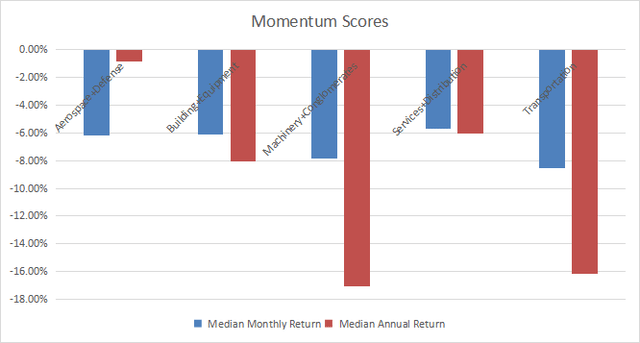[ad_1]
viper-zero/iStock Editorial via Getty Images
This monthly article series shows a dashboard with aggregate subsector metrics in industrials. It is also a top-down analysis of sector ETFs like the Industrial Select Sector SPDR ETF (XLI) and the Fidelity MSCI Industrials Index ETF (NYSEARCA:FIDU), whose largest holdings are used to calculate these metrics.
Shortcut
The next two paragraphs in italic describe the dashboard methodology. They are necessary for new readers to understand the metrics. If you are used to this series or if you are short of time, you can skip them and go to the charts.
Base Metrics
I calculate the median value of five fundamental ratios for each subsector: Earnings Yield (“EY”), Sales Yield (“SY”), Free Cash Flow Yield (“FY”), Return on Equity (“ROE”), Gross Margin (“GM”). The reference universe includes large companies in the U.S. stock market. The five base metrics are calculated on trailing 12 months. For all of them, higher is better. EY, SY and FY are medians of the inverse of Price/Earnings, Price/Sales and Price/Free Cash Flow. They are better for statistical studies than price-to-something ratios, which are unusable or non available when the “something” is close to zero or negative (for example, companies with negative earnings). I also look at two momentum metrics for each group: the median monthly return (RetM) and the median annual return (RetY).
I prefer medians to averages because a median splits a set in a good half and a bad half. A capital-weighted average is skewed by extreme values and the largest companies. My metrics are designed for stock-picking rather than index investing.
Value and Quality Scores
I calculate historical baselines for all metrics. They are noted respectively EYh, SYh, FYh, ROEh, GMh, and they are calculated as the averages on a look-back period of 11 years. For example, the value of EYh for transportation in the table below is the 11-year average of the median Earnings Yield in transportation companies. The Value Score (“VS”) is defined as the average difference in % between the three valuation ratios (EY, SY, FY) and their baselines (EYh, SYh, FYh). The same way, the Quality Score (“QS”) is the average difference between the two quality ratios (ROE, GM) and their baselines (ROEh, GMh).
The scores are in percentage points. VS may be interpreted as the percentage of undervaluation or overvaluation relative to the baseline (positive is good, negative is bad). This interpretation must be taken with caution: the baseline is an arbitrary reference, not a supposed fair value. The formula assumes that the three valuation metrics are of equal importance.
Current data
The next table shows the metrics and scores as of last week’s closing. Columns stand for all the data named and defined above.
|
VS |
QS |
EY |
SY |
FY |
ROE |
GM |
EYh |
SYh |
FYh |
ROEh |
GMh |
RetM |
RetY |
|
|
Aerospace+Defense |
-25.43 |
-10.25 |
0.0541 |
0.6045 |
0.0210 |
18.33 |
19.95 |
0.0563 |
0.8075 |
0.0398 |
20.47 |
22.18 |
-6.16% |
-0.82% |
|
Building+Equipment |
-45.77 |
19.81 |
0.0312 |
0.3117 |
0.0121 |
10.70 |
32.72 |
0.0426 |
0.8458 |
0.0230 |
9.56 |
25.62 |
-6.14% |
-8.03% |
|
Machinery+Conglomerates |
-13.39 |
5.93 |
0.0524 |
0.4427 |
0.0233 |
20.69 |
39.13 |
0.0498 |
0.5555 |
0.0311 |
19.19 |
37.60 |
-7.83% |
-17.10% |
|
Services+Distribution |
-21.86 |
25.05 |
0.0370 |
0.3096 |
0.0241 |
33.19 |
49.80 |
0.0408 |
0.4842 |
0.0302 |
22.35 |
49.05 |
-5.68% |
-6.07% |
|
Transportation |
43.88 |
-1.87 |
0.0540 |
1.0011 |
0.0381 |
29.71 |
17.87 |
0.0541 |
0.6991 |
0.0202 |
22.95 |
26.76 |
-8.52% |
-16.14% |
Value and Quality chart
The next chart plots the Value and Quality Scores by subsectors (higher is better).
Value and Quality in Industrials (Chart: author; data: Portfolio123)
Evolution since last month
Since last month, the building/construction/equipment subsector has deteriorated in value and quality.
Score Variations (Chart: author; data: Portfolio123)
Momentum
The next chart plots momentum data.
Momentum in Industrials (Chart: author; data: Portfolio123)
Interpretation
The transportation industry is undervalued by a wide margin relative to 11-year averages and its quality score is close to the baseline. Other subsectors are overvalued by 13% to 46% relative to historical averages. It may be partly justified by a good quality score for services and distribution, and to a lesser extent for the building/construction/equipment subsector. Aerospace/defense has both value and quality scores significantly below the baseline.
Fast facts on FIDU
The Fidelity MSCI Industrials Index ETF has been tracking the MSCI US IMI Industrials 25/25 Index since 10/21/2013. It has a total expense ratio of 0.08%, cheaper than XLI (0.12%).
As of writing, the fund holds 363 stocks. The next table shows the top 10 holdings with their valuation ratios and dividend yields. Their aggregate weight is 31.5%.
|
Ticker |
Name |
Weight |
EPS growth %TTM |
P/E TTM |
P/E fwd |
Yield% |
|
RTX |
Raytheon Technologies Corp. |
3.98% |
255.44 |
31.88 |
18.61 |
2.48 |
|
UNP |
Union Pacific Corp. |
3.95% |
36.24 |
19.60 |
17.68 |
2.52 |
|
HON |
Honeywell International Inc. |
3.73% |
15.19 |
23.87 |
20.59 |
2.18 |
|
UPS |
United Parcel Service Inc. |
3.72% |
104.00 |
13.97 |
13.36 |
3.55 |
|
CAT |
Caterpillar Inc. |
3.27% |
90.57 |
16.15 |
15.47 |
2.49 |
|
LMT |
Lockheed Martin Corp. |
3.06% |
-8.63 |
17.84 |
15.03 |
2.77 |
|
DE |
Deere & Co. |
2.95% |
32.12 |
16.84 |
13.93 |
1.40 |
|
GE |
General Electric Co. |
2.41% |
-85.06 |
N/A |
23.03 |
0.48 |
|
MMM |
3M Co. |
2.41% |
-1.97 |
13.52 |
12.12 |
4.59 |
|
BA |
Boeing Co. |
2.05% |
59.77 |
N/A |
N/A |
0 |
FIDU has underperformed XLI since FIDU inception (see next table). However, the difference in annualized return is only 58 bps. The maximum drawdown and volatility are almost identical.
|
Total Return |
Annual. Return |
Drawdown |
Sharpe |
Volatility |
|
|
FIDU |
97.84% |
8.21% |
-39.59% |
0.54 |
17.83% |
|
XLI |
107.15% |
8.79% |
-39.66% |
0.6 |
17.63% |
Data calculated with Portfolio123
In summary, FIDU is a good product with cheap management fees for investors seeking capital-weighted exposure in industrials. It has much more holdings than XLI (363 vs. 75), but it doesn’t make a significant difference in performance between them since 2013. The heaviest industries in the fund’s equity value are machinery (20.75%) and aerospace/defense (17.71%). The heaviest holding weighs about 4%, so the risk related to individual stocks is quite low. Investors willing a lower maximum weight may prefer the Invesco S&P 500® Equal Weight Industrials ETF (RGI), whose largest holdings weighs about 2% of asset value. FIDU and XLI are similar for buy-and-hold investors. However, XLI has a much higher liquidity, making it a better choice for trading and tactical allocation.
Dashboard List
I use the first table to calculate value and quality scores. It may also be used in a stock-picking process to check how companies stand among their peers. For example, the EY column tells us that a transportation company with an Earnings Yield above 0.0540 (or price/earnings below 18.52) is in the better half of the subsector regarding this metric. A Dashboard List is sent every month to Quantitative Risk & Value subscribers with the most profitable companies standing in the better half among their peers regarding the three valuation metrics at the same time. The list below was sent to subscribers several weeks ago based on data available at this time.
|
RHI |
Robert Half International Inc. |
|
BCO |
Brink’s Co. |
|
MATX |
Matson Inc. |
|
BCC |
Boise Cascade Co. |
|
WIRE |
Encore Wire Corp. |
|
BLDR |
Builders FirstSource Inc. |
|
XPO |
XPO Logistics Inc. |
|
VNT |
Vontier Corp. |
|
AJRD |
Aerojet Rocketdyne Holdings Inc. |
|
CARR |
Carrier Global Corp. |
It is a rotating list with a statistical bias toward excess returns on the long-term, not the result of an analysis of each stock.
[ad_2]
Source links Google News

